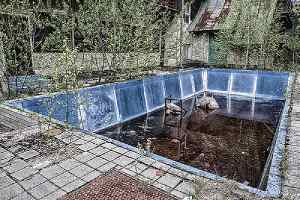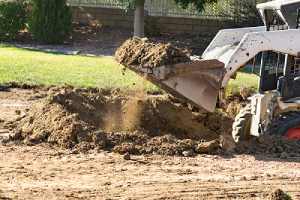 Removing an old swimming pool can come with many benefits, including saving both time and money and eliminating certain hazards associated with in-ground pools. Homeowners can also lower liability risk by removing a pool from their homes. In addition, the removal of an old swimming pool allows for greater yard space to open up for landscaping, or backyard activities. While the removal process is fairly straightforward, there are still certain risks to consider. If a homeowner fails to properly refill the foundation, sinkholes can develop. Fill dirt can be a great advantage when dealing with sinkholes created by a poor pool removal process.
Removing an old swimming pool can come with many benefits, including saving both time and money and eliminating certain hazards associated with in-ground pools. Homeowners can also lower liability risk by removing a pool from their homes. In addition, the removal of an old swimming pool allows for greater yard space to open up for landscaping, or backyard activities. While the removal process is fairly straightforward, there are still certain risks to consider. If a homeowner fails to properly refill the foundation, sinkholes can develop. Fill dirt can be a great advantage when dealing with sinkholes created by a poor pool removal process.
The Pool Demolition & Removal Process
There are two main approaches when it comes to a proper pool removal process. If you’re looking for a more cost-effective and less time-consuming process, homeowners can opt to undergo a partial pool demolition. During a partial pool removal, the pool is completely drained of water and multiple holes are drilled at the bottom of the pool in order to prevent water from collecting underneath. The upper half of the pool wall, around two to three feet, are then demolished while the rest of the pool remains intact. The remaining pool area is then backfilled and compacted to prevent future sinking.
If you’re looking for a more extensive pool removal, a complete pool demolition may be the option for you. This process involves the full breakdown of the pool structure. Once the structure is broken down, the rest of the material is hauled away. The concrete, tiles, and other components are taken away to be disposed of, rather than being buried in the backfill like they would in partial pool removal. Complete pool removal is recommended if you plan on building a new structure in that area in the future. This will help to prevent any sinkage or shifting that could occur. Understanding the costs of the two pool removals is important. Since materials need to be broken up and disposed of properly, a complete pool removal will cost significantly more than a partial demolition.
Sinkholes & Pool Removals
 Sinkholes are most common in terrains where limestone, salt beds, gypsum or carbonate rock may dissolve. Over time, water eats away at the rock until a pit is formed. The overlying sediment layer then loses its support and collapses into the pit, creating a sinkhole.
Sinkholes are most common in terrains where limestone, salt beds, gypsum or carbonate rock may dissolve. Over time, water eats away at the rock until a pit is formed. The overlying sediment layer then loses its support and collapses into the pit, creating a sinkhole.
Types of Sinkholes After Pool Removal
There are two main types of sinkholes that can develop on residential property after a faulty removal. The first is a cover-subsidence hole and occurs when thick, permeable sediment lies over limestone or another soluble rock. As the rock dissolves, the sediment gradually sinks and creates a depression in the ground.
The second type of sinkhole, a cover-collapse, is a much more hazardous sinkhole that can develop. When performing a pool removal, it is vital to stay vigilant in order to prevent this from happening. A cover-collapse sinkhole will typically occur within minutes and is often triggered by a weather-related event. When these weather events, such as heavy rainfall, occur, the sediment that covers the void underneath can suddenly collapse and leave behind a hole. While sinkholes are most common in areas where there is soluble rock, they can develop almost anywhere.
Preventing Pool Removal Sinkholes
One of the easiest ways to prevent sinkholes after a pool removal is by working with a reputable pool removal contractor. The contractor will take the necessary steps to reduce the possibility of sinkholes forming, and take all precautions. These precautions may include laying down commercial-grade geotextile fabric over the rubble to prevent the fill soil from falling through into the rubble. This fill material should also be compacted into the pool cavity using a vibratory trench roller. While some contractors choose to drive the skid loader over the fill material to compact it, it is not the proper method. Using the proper equipment to compact the fill dirt is crucial in preventing settling problems such as sinkholes.
Working With A Quality Pool Removal Contractor
When thinking about a pool removal process, working with a qualified contractor can make a huge difference in the project results. A professional contractor will be thorough and take the time to break up the pool materials. If concrete and other pool components are not properly broken up, there is a high risk of moisture becoming trapped. This moisture will push the pool up to the surface, resulting in an expensive fix. If you choose to undergo a partial removal, components must be properly broken up and pushed into the pool to help fill the cavity. This will also reduce the amount of soil filler and gravel needed, ultimately saving money.
Add A Layer Of Gravel
 Once the debris is thoroughly crushed and tamped down, a layer of gravel should be added to the pool cavity in one-foot layers. Each layer should be completely compacted down before the next layer is added. Each of these layers helps to provide a gravel foundation that contains the pool debris underground, and also provides a foundation for the soil to sit upon. Over time, the soil shrinks and decompresses. The layer of gravel will not decompress and stay firmly in place. Additional protection can be added in the form of a PVC pipe along the length of the pool for drainage. A pool removal contractor can include additional protection by installing a PVC pipe along the length of the pool to help drain properly and prevent underground water from creating a mudslide.
Once the debris is thoroughly crushed and tamped down, a layer of gravel should be added to the pool cavity in one-foot layers. Each layer should be completely compacted down before the next layer is added. Each of these layers helps to provide a gravel foundation that contains the pool debris underground, and also provides a foundation for the soil to sit upon. Over time, the soil shrinks and decompresses. The layer of gravel will not decompress and stay firmly in place. Additional protection can be added in the form of a PVC pipe along the length of the pool for drainage. A pool removal contractor can include additional protection by installing a PVC pipe along the length of the pool to help drain properly and prevent underground water from creating a mudslide.
Adding Topsoil
After the gravel is placed, topsoil can be added for aesthetic and landscaping purposes. If you wish to plant any grass, flowers, or crops, the soil should be a minimum of three feet deep. The soil will need to be even deeper if you plan on planting any trees. When properly executed, your yard will appear as if a swimming pool never existed! It is important to remain vigilant of any warning signs of impending sinkholes. These signs include the sagging, slumping, or slanting of trees or fence posts. They can also include cracks in the floors, walls or pavements, or falling doors and windows close to the property.
Speak To A Qualified Pool Removal Contractor
Filling in an in-ground swimming pool is a serious decision, and it comes with many risks about the stability of the ground. No matter if you choose to undergo a partial or full pool removal, the pool removal contractors at Dirt Connections can greatly enhance your pool removal project. The risks associated with a pool removal can lead to expensive costs if not done properly. An experienced pool removal contractor, coupled with the right materials, can drastically reduce the likelihood of sinkholes after pool removal. If you’d like more information, or to schedule a pool removal project, contact the qualified pool removal contractors at Dirt Connections today.
Summary

Dirt Connections was started with one goal in mind: providing quality residential and commercial construction services to clients on time and on budget. Reach out for more information on how we can support your next project.
For your convenience our estimates are free and by appointment. Call 703-940-9949 for a free estimate today!









































